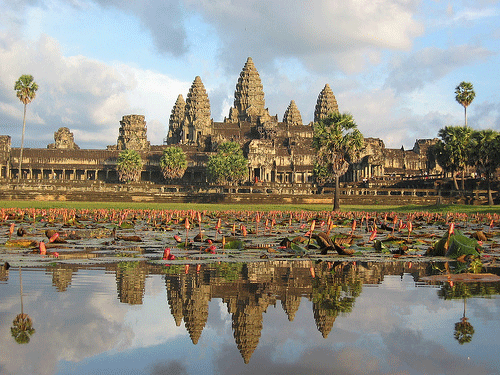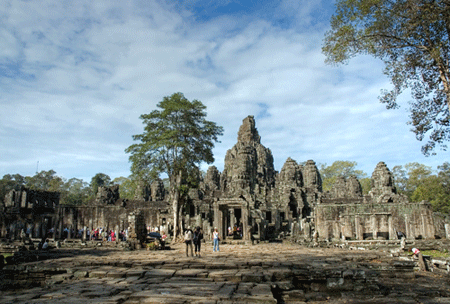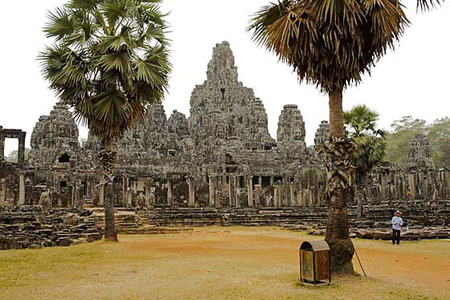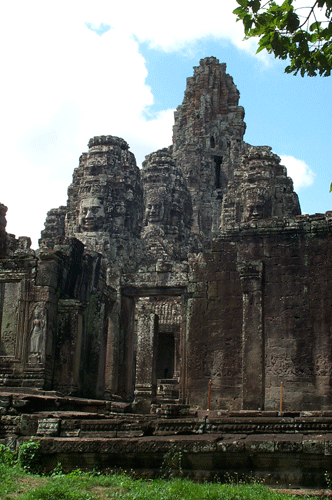History
The Bayon was the last state temple to be built at Angkor, and the only Angkorian state temple to be built primarily as a Mahayana Buddhist shrine dedicated to the Buddha, though a great number of minor and local deities were also encompassed as representatives of the various districts and cities of the realm. It was the centrepiece of Jayavarman VII’s massive program of monumental construction and public works, which was also responsible for the walls and naga-bridges of Angkor Thom and the temples of Preah Khan, Ta Prohm and Banteay Kdei.
The similarity of the 216 gigantic faces on the temple’s towers to other statues of the king has led many scholars to the conclusion that the faces are representations of Jayavarman VII himself. Others have said that the faces belong to the bodhisattva of compassion called Avalokitesvara or Lokesvara. The two hypotheses need not be regarded as mutually exclusive. Angkor scholar George Coedès has theorized that Jayavarman stood squarely in the tradition of the Khmer monarchs in thinking of himself as a “devaraja” (god-king), the salient difference being that while his predecessors were Hindus and regarded themselves as consubstantial with Shiva and his symbol the lingam, Jayavarman as a Buddhist identified himself with the Buddha and the bodhisattva.
The site
The temple is orientated towards the east, and so its buildings are set back to the west inside enclosures elongated along the east-west axis. Because the temple sits at the exact centre of Angkor Thom, roads lead to it directly from the gates at each of the city’s cardinal points. The temple itself has no wall or moats, these being replaced by those of the city itself: the city-temple arrangement, with an area of 9 square kilometres, is much larger than that of Angkor Wat to the south (2 km²). Within the temple itself, there are two galleried enclosures (the third and second enclosures) and an upper terrace (the first enclosure). All of these elements are crowded against each other with little space between. Unlike Angkor Wat, which impresses with the grand scale of its architecture and open spaces, the Bayon “gives the impression of being compressed within a frame which is too tight for it.
The outer gallery: depictions of historical events and everyday life
The outer wall of the outer gallery features a series of bas-reliefs depicting historical events and scenes from the everyday life of the Angkorian Khmer. Though highly detailed and informative in themselves, the bas-reliefs are not accompanied by any sort of epigraphic text, and for that reason considerable uncertainty remains as to which historical events are portrayed and how, if at all, the different reliefs are related.
The inner gallery: depictions of mythological events
The inner gallery is raised above ground level and has doubled corners, with the original redented cross-shape later filled out to a square. Its bas-reliefs, later additions of Jayavarman VIII, are in stark contrast to those of the outer: rather than set-piece battles and processions, the smaller canvases offered by the inner gallery are decorated for the most part with scenes from Hindu mythology. Some of the figures depicted are Siva, Vishnu, and Brahma, the members of the trimurti or threefold godhead of Hinduism, Apsaras or celestial dancers, Ravana and Garuda. There is however no certainty as to what some of the panels depict, or as to their relationship with one another. One gallery just north of the eastern gopura, for example, shows two linked scenes which have been explained as the freeing of a goddess from inside a mountain, or as an act of iconoclasm by Cham invaders. Another series of panels shows a king fighting a gigantic serpent with his bare hands, then having his hands examined by women, and finally lying ill in bed; these images have been connected with the legend of the Leper King, who contracted leprosy from the venom of a serpent with whom he had done battle. Less obscure are depictions of the construction of a Vishnuite temple (south of the western gopura) and the Churning of the Sea of Milk (north of the western gopura).
The upper terrace: 200 faces of Lokesvara
The inner gallery is nearly filled by the upper terrace, raised one level higher again. The lack of space between the inner gallery and the upper terrace has led scholars to conclude that the upper terrace did not figure in the original plan for the temple, but that it was added shortly thereafter following a change in design. Originally, it is believed, the Bayon had been designed as a single-level structure, similar in that respect to the roughly contemporaneous foundations at Ta Prohm and Banteay Kdei.
The upper terrace is home to the famous “face towers” of the Bayon, each of which supports two, three or (most commonly) four gigantic smiling faces. In addition to the mass of the central tower, smaller towers are located along the inner gallery (at the corners and entrances), and on chapels on the upper terrace. “Wherever one wanders,” writes Maurice Glaize, the faces of Lokesvara follow and dominate with their multiple presence.”
Efforts to read some significance into the numbers of towers and faces have run up against the circumstance that these numbers have not remained constant over time, as towers have been added through construction and lost to attrition. At one point, the temple was host to 49 such towers; now only 37 remain. The number of faces is approximately 200, but since some are only partially preserved there can be no definitive count.
The central tower and sanctuary
Like the inner gallery, the central tower was originally cruciform but was later filled out and made circular. It rises 43 metres above the ground. At the time of the temple’s foundation, the principal religious image was a statue of the Buddha, 3.6 m tall, located in the sanctuary at the heart of the central tower. The statue depicted the Buddha seated in meditation, shielded from the elements by the flared hood of the serpent king Mucalinda. During the reign of Hindu restorationist monarch Jayavarman VIII, the figure was removed from the sanctuary and smashed to pieces. After being recovered in 1933 from the bottom of a well, it was pieced back together, and is now on display in a small pavilion at Angkor.
http://www.wikipedia.org








